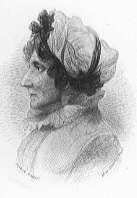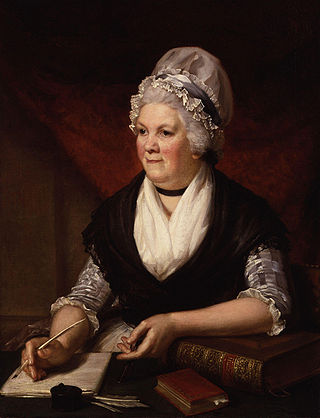See also
British children's literature | |
|---|---|
| Eighteenth-century | |
| Nineteenth-century | |
| Twentieth-century | |
This is a list of 18th-century British children's literature titles (ordered by year of publication):

Anna Laetitia Barbauld was a prominent English poet, essayist, literary critic, editor, and author of children's literature. A prominent member of the Blue Stockings Society and a "woman of letters" who published in multiple genres, Barbauld had a successful writing career that spanned more than half a century.

Sarah Trimmer was a writer and critic of 18th-century British children's literature, as well as an educational reformer. Her periodical, The Guardian of Education, helped to define the emerging genre by seriously reviewing children's literature for the first time; it also provided the first history of children's literature, establishing a canon of the early landmarks of the genre that scholars still use today. Trimmer's most popular children's book, Fabulous Histories, inspired numerous children's animal stories and remained in print for over a century.

The Randolph family of Virginia is a prominent political family, whose members contributed to the politics of Colonial Virginia and Virginia after statehood. They are descended from the Randolphs of Morton Morrell, Warwickshire, England. The first Randolph in America was Edward Fitz Randolph, who settled in Massachusetts in 1630. His nephew, William Randolph, later came to Virginia as an orphan in 1669. He made his home at Turkey Island along the James River. Because of their numerous progeny, William Randolph and his wife, Mary Isham Randolph, have been referred to as "the Adam and Eve of Virginia". The Randolph family was the wealthiest and most powerful family in 18th-century Virginia.

Ellenor Fenn was a prolific 18th-century British writer of children's books.

Lessons for Children is a series of four age-adapted reading primers written by the prominent 18th-century British poet and essayist Anna Laetitia Barbauld. Published in 1778 and 1779, the books initiated a revolution in children's literature in the Anglo-American world. For the first time, the needs of the child reader were seriously considered: the typographically simple texts progress in difficulty as the child learns. In perhaps the first demonstration of experiential pedagogy in Anglo-American children's literature, Barbauld's books use a conversational style, which depicts a mother and her son discussing the natural world. Based on the educational theories of John Locke, Barbauld's books emphasise learning through the senses.

Hymns in Prose for Children (1781) is a children's book by Anna Laetitia Barbauld.

The Livingston family of New York is a prominent family that migrated from Scotland to the Dutch Republic, and then to the Province of New York in the 17th century. Descended from the 4th Lord Livingston, its members included signers of the United States Declaration of Independence and the United States Constitution. Several members were Lords of Livingston Manor and Clermont Manor, located along the Hudson River in 18th-century eastern New York.

The Quincy family was a prominent political family in Massachusetts from the mid-17th century through to the early 20th century. It is connected to the Adams political family through Abigail Adams.

John Marshall (1756–1824) was a London publisher who specialized in children's literature, chapbooks, educational games and teaching schemes. He called himself the "Children's Printer" and children his "young friends". He was pre-eminent in England as a children's book publisher from about 1780 to 1800. After 1795, he became the publisher of Hannah More's Cheap Repository Tracts, but a dispute with her led to him issuing a similar series of his own. About 1800 Marshall began publishing a series of miniature libraries, games and picture books for children. After his death in July 1824, his business was continued either by his widow or his unmarried daughter, both of whom were named Eleanor.

Mary Ann Kilner was a prolific English writer of children's books in the late 18th century. The most famous was The Adventures of a Pincushion. Together, she and her sister-in-law, Dorothy Kilner, published over thirty books. Mary Ann published under the name "S. S.", which stood for her home in Spital Square, London.
Edward Augustus Kendall was a British translator, social campaigner and miscellaneous writer.

Thomas Boreman was one of the earliest English children's book publishers particularly dealing with animals. His bookshops were located around London

Susannah Taylor or Susannah Cook was a British socialite and correspondent.

Mary Scott's The Female Advocate; a poem occasioned by reading Mr. Duncombe's Feminead (1775) is both a celebration of women's literary achievements, as well as an impassioned piece of advocacy for women's right to literary self-expression.